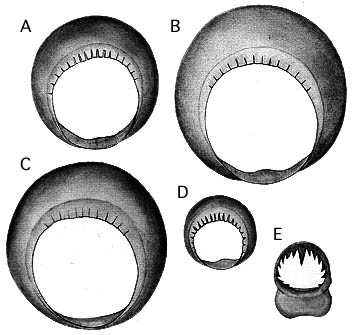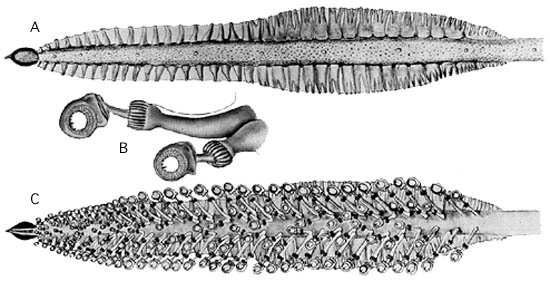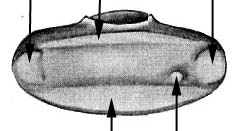- Arms
- Arms I 80-100% of ML.
- Arms III 115-152% of ML
- Arms IV 167-210% 0f ML
- Largest suckers with nearly smooth rings, proximal suckers with 18-20 separate, truncate teeth on distal 2/3 of ring.
- Largest suckers globular; largest suckers on arms III more than three times diameter of corresponding arm IV suckers.
Figure. Oral views of the inner rings of arm and tentacle suckers of C. calyx, 60 mm ML: A - Large sucker from arm I (row 6); B - Large sucker from arm III (row 13); C - Large sucker from arm II (row 10); D - Large sucker from arm IV (row 1). Relative sucker sizes maintained. Drawings from Young, 1972.
- Tentacular clubs
- Club length 57-67% of ML.
- Suckers with 11-14 pointed teeth, with bases in contact, over distal 1/2-3/4 of ring; central tooth enlarged.
- Sucker stalks in two distinct parts; stalks of suckers in lateral series much longer than those in medial series.
- Protective membranes
- Membranes in two distinct sets of about equal lengths, proximal set slightly broader.
- Proximal set with separate trabeculae (approx. 17), each split distally into two or three parts, except for initial one or two.
- Distal set with about 18 single, separate trabeculae.
Figure. Tentacular clubs of C. calyx: A - Aboral view of club, 60 mm ML. Note arrangement of trabeculae in the proximal section of the protective membrane and the photophores embedded in the midline of the club. B - Suckers with stalks (holotype, 60 mm ML). Note the larger size of the lateral sucker stalk, the short, well-defined pleates (dark stripes), and the two parts to the stalk (thick basal section terminating in the pleates and a narrow distal section); C - Oral view of club, 60 mm ML. Drawings from Young, 1972.
- Head
- Head length ca. 40% of ML.
- Head length ca. 40% of ML.
- Funnel
- Tragus and antitragus of the funnel-locking apparatus present, tragus much larger.
Figure. Frontal view of funnel locking-apparatus of C. calyx, 60 mm ML. Drawing from Young (1972).
- Fins
- Fin length ca. 40% of ML.
- Fin width ca. 40% of ML.
- Photophores
- Eyeball: lateral series = stripe; medial series = stripe; intermediate series = one large round anterior, one large round posterior and one small round offset slightly medially near anterior photophore.
- Viscera: two on ink sac.
- Club-tip photophore small and with small papilla.
- 12 organs embedded in aboral surface of club.
- Series of large, round photophores on Arms IV.
- Stalk pad-like photophores become embedded ca. one club length proximal to club.
Figure. Ventral view of the eyeball of C. calyx, holotype, 60 mm ML. Arrows point to the three circular and two strip photophores; posterior is at the right in the drawing. Drawing from Young (1972).
- Pigmentation
- Club-tip photophore surrounded by dark epithelial pigment.
- Remaining club pigment in chromatophore organs.
- Club sucker stalks pleated, otherwise stalks unpigmented.
- Buccal membrane virtually unpigmented except for few scattered chromatophores.
- Olfactory organ unpigmented.
Chiroteuthis calyx: Description continued
Richard E. Young and Clyde F. E. RoperAbout This Page

University of Hawaii, Honolulu, HI, USA

Smithsonian Institution, Washington, D. C., USA
Page copyright © 1999
 Page: Tree of Life
Chiroteuthis calyx: Description continued
Authored by
Richard E. Young and Clyde F. E. Roper.
The TEXT of this page is licensed under the
Creative Commons Attribution-NonCommercial License - Version 3.0. Note that images and other media
featured on this page are each governed by their own license, and they may or may not be available
for reuse. Click on an image or a media link to access the media data window, which provides the
relevant licensing information. For the general terms and conditions of ToL material reuse and
redistribution, please see the Tree of Life Copyright
Policies.
Page: Tree of Life
Chiroteuthis calyx: Description continued
Authored by
Richard E. Young and Clyde F. E. Roper.
The TEXT of this page is licensed under the
Creative Commons Attribution-NonCommercial License - Version 3.0. Note that images and other media
featured on this page are each governed by their own license, and they may or may not be available
for reuse. Click on an image or a media link to access the media data window, which provides the
relevant licensing information. For the general terms and conditions of ToL material reuse and
redistribution, please see the Tree of Life Copyright
Policies.






 Go to quick links
Go to quick search
Go to navigation for this section of the ToL site
Go to detailed links for the ToL site
Go to quick links
Go to quick search
Go to navigation for this section of the ToL site
Go to detailed links for the ToL site